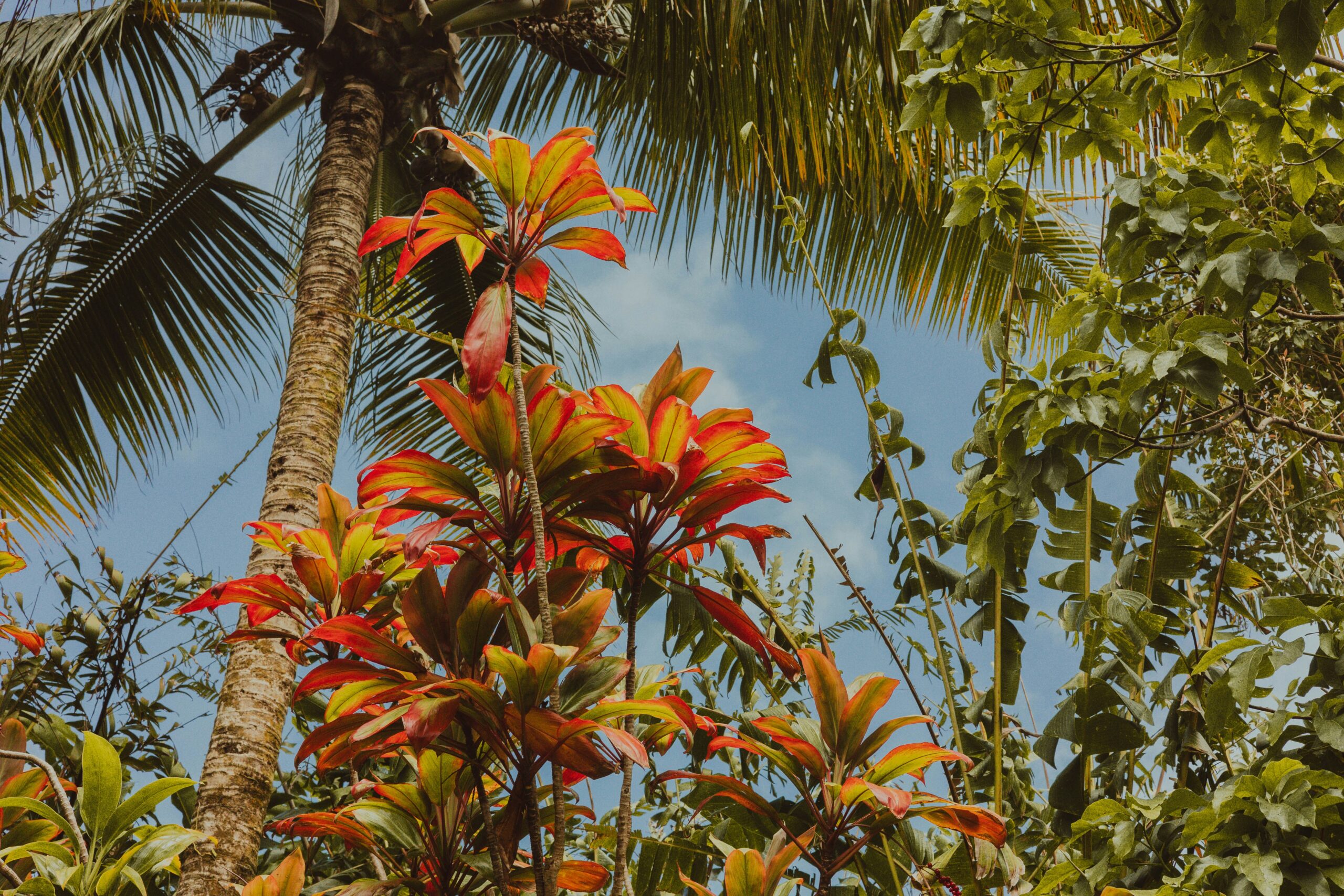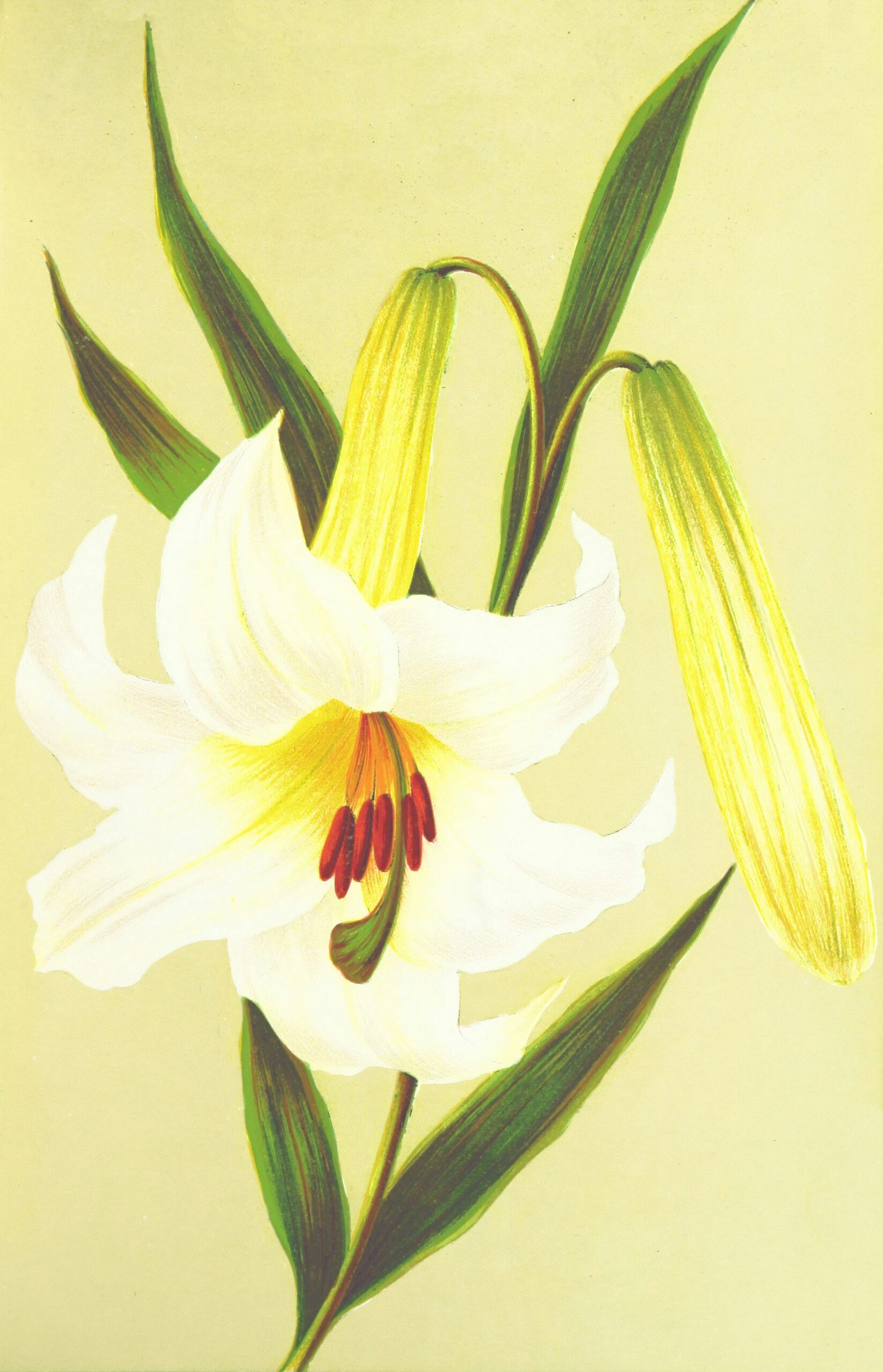Introduction to Tropical Plants
Tropical plants are a diverse group of flora that typically thrive in warm, humid climates near the equator. These plants are characterized by their lush foliage, vibrant colors, and remarkable adaptability to their ecological niches. The term “tropical” encompasses a vast array of plant species, including trees, shrubs, and flowering plants, all of which play vital roles in their respective ecosystems. The climate suitable for tropical plants generally features high temperatures and ample rainfall, conditions that foster a rich biodiversity often not found in temperate regions.
One of the most enchanting aspects of tropical flora is the presence of striking flowers. Among them, white flowers stand out for their pure aesthetic, often symbolizing peace and tranquility. These flowers can add elegance and beauty to both natural landscapes and cultivated gardens. The contrast between the intense greens of tropical leaves and the delicate softness of white blooms creates a visual harmony that captivates the eye and enhances outdoor spaces. Furthermore, many tropical plants with white flowers also serve significant ecological functions, attracting pollinators such as bees and butterflies, which are crucial for the survival of various plant species.
The allure of white flowering tropical plants is not merely about aesthetics; it reflects a larger narrative concerning the importance of tropical regions. These areas contribute to the global environment by maintaining atmospheric balance, supporting diverse wildlife, and regulating climate. As we delve deeper into the world of tropical plants, particularly those adorned with stunning white flowers, we will uncover their unique characteristics, care requirements, and the essential role they play in both nature and human landscapes. This exploration highlights why tropical plants are cherished not just for their beauty but also for their intrinsic value within ecosystems.
Plumeria (Frangipani)
Plumeria, commonly known as Frangipani, is a genus of flowering plants renowned for their stunning white flowers that exude a captivating fragrance. Often found in tropical regions, these plants are integral to various cultural practices, symbolizing love, beauty, and devotion. Plumeria species, particularly Plumeria alba, are celebrated for their pure white blossoms, which frequently serve as decorative accents in landscapes and traditional ceremonies.
In terms of growth habits, Plumeria plants are deciduous, meaning they lose their leaves during dry seasons and bloom profusely with vibrant flowers when conditions are favorable. These tropical plants can grow up to 3 to 10 feet tall, depending on the species and the care they receive. They thrive in well-drained soil and prefer full sun exposure, making them an excellent choice for gardens in warm climates.
For optimal growth, Plumeria requires temperatures between 65°F to 80°F and should be protected from frost. When cultivating this enticing plant, it is essential to mimic its natural habitat by providing adequate water during the growing season, without allowing the soil to become waterlogged. During the winter months, watering should be reduced significantly as the plant enters dormancy. A balanced fertilizer can be applied every few months to promote healthy growth and maximize blooming potential.
Plumeria is relatively low-maintenance, making it suitable for both novice gardeners and seasoned horticulturists. Regular pruning can help to shape the plant and encourage bushier growth. Additionally, planting these tropical plants in containers allows for relocation if environmental conditions change. Overall, with the right care and attention, Plumeria can be a delightful addition to any tropical landscape, offering a sensory delight with its exquisite blooms and alluring fragrance.
Bougainvillea
Bougainvillea is a popular tropical plant, well-known for its vivid and colorful bracts, which often overshadow the insignificant white flowers that bloom among them. These vibrant bracts make Bougainvillea not only a desirable plant for gardeners but also a versatile choice for various landscaping applications. Selecting varieties that particularly produce white flowers can create an exquisite contrast in any garden or outdoor space.
Some remarkable varieties primarily known for their white blooms include the ‘Royal Delight’ Bougainvillea and the ‘Sundown White’ variant. These plants not only add elegance to the landscape but also display a resilience to various climatic conditions, making them suitable for different regions. Bougainvillea thrives in full sunlight, requiring at least five to six hours of direct sunlight daily for optimal growth and flowering. Proper watering techniques are crucial for this tropical plant; it prefers well-draining soil and tolerates drought. Overwatering should be avoided, as it can lead to root rot.
Cultivating Bougainvillea in warmer climates promotes an abundance of flowering. To enhance flowering potential, gardeners should occasionally prune the plant, encouraging bushier growth and the production of buds. This tropical plant is also highly adaptable, often used to create stunning vertical gardens, trellis displays, and even as ground cover. Its striking white flowers can provide a serene elegance when paired with other colorful varieties, achieving a harmonious balance in landscaping designs.
With proper care and thoughtful planting strategies, Bougainvillea can flourish and create a visually appealing space. Its impressive ability to produce showy white flowers amidst resplendent bracts sets this tropical plant apart, making it a favorite among both amateur and professional gardeners alike.
Gardenia
Gardenias are a beloved variety of tropical plants, renowned for their exquisite white flowers and intoxicating fragrance. These ornamental shrubs can grow to a height of four to six feet, making them an iconic choice for landscaping and gardens. The glossy, dark green foliage provides a stunning backdrop for the creamy white blooms that emerge in the spring and summer months. To achieve optimal growth, Gardenias require specific growing conditions.
These tropical plants thrive in well-drained, acidic soil that retains moisture without becoming waterlogged. It is essential to establish the right pH level, ideally between 5.0 and 6.0, to ensure vibrant growth and abundant flowering. They flourish in a location that receives full to partial sunlight, ideally four to six hours of direct light each day. During the hot summer months, providing some shade during the afternoon can help protect the plants from scorching.
Caring for Gardenias involves regular watering and fertilization. It is crucial to maintain consistent moisture, particularly during blooming periods. A balanced, slow-release fertilizer formulated for acidic-loving plants is recommended every six to eight weeks during the growing season. Regular pruning after flowering can help maintain the desired shape and encourage lush foliage.
While Gardenias are generally robust, they are susceptible to pests such as aphids and whiteflies, which can affect their overall health. Implementing preventive measures, such as insecticidal soap or neem oil, can help manage pest populations effectively. Additionally, maintaining proper air circulation around the plants can reduce the risk of fungal diseases. By adhering to these care guidelines, your Gardenia plants will thrive, showcasing their stunning white flowers and captivating fragrance in your tropical garden.
White Ginger Lily (Hedychium coronarium)
The White Ginger Lily, scientifically known as Hedychium coronarium, is a striking tropical plant celebrated for its elegant, aromatic spikes of white flowers. Native to the tropical regions of Asia, this perennial plant is renowned for its capacity to thrive in various environments, making it a favorite among gardeners seeking to enhance their landscaping with exotic flora. Grown primarily in USDA hardiness zones 7 to 11, the White Ginger Lily flourishes in well-draining, moist soil, complemented by ample sunlight and humidity, which mimics its natural habitat.
Ecologically, the White Ginger Lily plays a significant role within its ecosystem. Its flowers, which bloom throughout the summer and fall, are not only visually pleasing but also serve as a vital food source for pollinators, including bees and butterflies. By attracting these species, the plant supports biodiversity and contributes to the health of the local environment. Moreover, its lush green foliage creates a shaded area that can be beneficial for other plants, promoting a thriving garden ecosystem.
Propagation of the White Ginger Lily can be achieved through division or by planting rhizomes. Dividing established clumps in the spring after the risk of frost has passed is the most effective method, as it allows for the development of new plants while rejuvenating the parent clump. When planting rhizomes, ensure they are placed at a shallow depth in rich, organic soil to facilitate optimal growth and flower production.
In tropical gardening, the White Ginger Lily is more than just an ornamental plant; it is valued for its fragrant blooms that can infuse an entire garden area with a delightful scent. Its elegant white flowers, coupled with its robust growth habit, make it a significant addition to any tropical landscape, providing aesthetic appeal and valuable ecological benefits.
5. Cattleya Orchids
Cattleya orchids are renowned for their spectacular blooms, particularly those varieties that produce striking white flowers. These stunning tropical plants are often considered the “corsage orchids” due to their large, showy flowers that can last for weeks. Among the various Cattleya species, some notable white-flowering varieties include Cattleya labiate and Cattleya trianae, which exhibit an exquisite elegance and grace.
To thrive, Cattleya orchids require specific growing conditions. They prefer warm temperatures, ideally ranging from 70 to 85 degrees Fahrenheit during the day, and cooler nights around 60 to 70 degrees Fahrenheit. High humidity levels, around 50-70%, also contribute to their health and flower production. Providing adequate air circulation is crucial in preventing common issues such as rot and pests. As they are epiphytic in nature, these tropical plants do well when mounted on bark or in well-draining potting media that replicates their natural habitat.
When it comes to potting Cattleya orchids, it is essential to select a pot that promotes drainage while allowing enough space for roots to expand. A mix of bark, charcoal, and perlite can create an ideal growing medium. Regularly monitoring the moisture levels is vital, as these orchids prefer to dry out slightly between waterings. Fertilization should occur during the growing season, with a balanced orchid fertilizer applied every two to four weeks. For encouraging blooms, ensure they receive indirect light, which aids in flower spikes’ development. Moreover, adjusting care routines leading up to flowering, such as reducing watering and fertilizer, can signal the plant to focus its energy on producing those stunning white flowers. By following these guidelines, both novice and experienced gardeners can enjoy the breathtaking beauty that Cattleya orchids bring to their collections.
Calla Lily
The Calla Lily, known scientifically as Zantedeschia, is a striking addition to any tropical landscape, celebrated for its distinctive trumpet-shaped white flowers. This elegant plant is native to southern Africa but has gained popularity in many tropical and subtropical regions worldwide. The Calla Lily is not only admired for its beauty but also for its versatility, making it a prevalent choice in gardens and floral arrangements.
To cultivate Calla Lilies successfully, it is essential to provide them with an ideal environment. These plants thrive in well-draining soil rich in organic matter, which enhances their growth and flowering potential. A location that provides partial shade is beneficial, as too much direct sunlight can lead to wilting and can diminish the vibrancy of the blooms. Calla Lilies prefer consistently moist soil, making regular watering crucial, especially during the blooming season. However, care must be taken not to overwater, as this can lead to root rot, which is detrimental to these delicate plants.
In tropical landscapes, Calla Lilies can be utilized effectively in a variety of settings. They work beautifully in borders or as focal points due to their tall stature and elegant flowers. Additionally, they can be planted in containers, allowing for flexibility in arranging outdoor spaces. For those looking to incorporate them into floral arrangements, Calla Lilies serve as exquisite cut flowers, lending an air of sophistication to bouquets. Their long-lasting blooms, when properly cared for, can enhance any interior or event, providing a touch of tropical beauty.
In conclusion, the Calla Lily stands out among tropical plants for its elegance and adaptability. With the right care and environment, this stunning flower can thrive, bringing beauty to gardens and homes alike.
7. Rafflesia arnoldii
Rafflesia arnoldii, renowned for producing one of the largest flowers in the world, is a remarkable species found predominantly in the tropical rainforests of Southeast Asia. Its striking, massive blooms can reach up to three feet in diameter, featuring a vibrant red color adorned with white spots, which makes it an astounding sight in its native habitat. Unlike most tropical plants, Rafflesia does not boast leaves or stems, as it is a parasitic plant that relies entirely on its host, primarily the vine species Tetrastigma, for nutrients.
This unique adaptation allows Rafflesia to thrive in the forest understory, where it plays a crucial role in its ecosystem. The flower emits a strong odor reminiscent of rotting flesh, which, while off-putting to humans, serves to attract specific pollinators, primarily carrion flies. This ecological relationship is essential for the reproduction of Rafflesia arnoldii, as it relies on these insects to transfer pollen from one bloom to another, thus ensuring genetic diversity and the continuity of the species.
The life cycle of Rafflesia arnoldii is equally fascinating. Once pollinated, the flower produces a fruiting body that releases seeds, which are then dispersed by animals or environmental factors. The seeds must find a suitable host vine to germinate, and developing into the parasitic stage can take several months to years. Despite its stunning appearance, Rafflesia faces several challenges in the wild. Habitat destruction due to deforestation and climate change poses significant threats to this iconic plant. Conservation efforts are crucial to ensure that Rafflesia arnoldii continues to thrive in its natural tropical environment, allowing future generations to appreciate its beauty and ecological importance.
Cassia Fistula (Golden Shower Tree)
Cassia Fistula, commonly known as the Golden Shower Tree, is a captivating tropical plant recognized for its stunning display of cascading white flowers. This deciduous tree can grow up to 10 to 20 meters in height and is native to the tropical regions of Southeast Asia. Its graceful, elongated flower clusters create a striking visual impact, attracting attention in any garden setting. During the blooming season, typically in late spring to early summer, the tree reveals an abundance of beautiful white flowers that can create an enchanting atmosphere.
The Golden Shower Tree not only thrives in tropical climates but also adapts well to subtropical regions. It prefers full sun and well-drained soil, ensuring its robust growth. Gardeners often employ propagation through seeds or cuttings, making it relatively easy to cultivate. While the tree is primarily valued for its ornamental qualities, it also plays a role in traditional medicine in certain cultures, with various parts of the plant utilized to treat ailments.
In addition to its aesthetic appeal, Cassia Fistula is known for its ecological benefits. The beautiful white flowers attract a variety of pollinators, including bees and butterflies, thereby supporting local ecosystems. Furthermore, the tree’s elegant foliage provides ample shade, making it a suitable choice for tropical gardens where shade is desired. In many regions, the Golden Shower Tree is revered not only for its beauty but also for its cultural significance and traditional uses, often being planted near temples or within community spaces.
With its enduring charm and versatility, Cassia Fistula remains a notable tropical plant that enhances the beauty of gardens, landscape designs, and urban settings, all while offering ecological benefits and cultural importance.
Conclusion: The Charm of White Flowers in Tropical Landscapes
The allure of white flowers among tropical plants is undeniably captivating. Throughout this blog post, we have explored a variety of tropical plants adorned with stunning white blooms, showcasing their beauty and the diversity they offer. Each plant not only contributes to the visual appeal of tropical landscapes but also plays a significant role in the ecosystem. The striking contrast of pure white flowers against lush green foliage enhances any garden, creating a serene and elegant atmosphere.
In addition to their aesthetic value, these tropical plants with white flowers also attract various pollinators, such as bees and butterflies, thereby promoting biodiversity in their respective environments. By integrating these plants into garden designs, enthusiasts can create vibrant spaces that flourish with life. The harmonious blend of white flowers amidst the vibrant colors of other tropical specimens can evoke a sense of tranquility and balance within the landscape, making them ideal choices for a wide range of outdoor settings.
Moreover, the adaptability of these tropical plants allows them to thrive in various conditions, making them suitable for both seasoned horticulturists and newcomers alike. With careful selection and planning, one can cultivate a tropical garden that not only delights the senses but also honors the ecological significance of these plants. Therefore, incorporating tropical plants with white flowers into your landscape design is a thoughtful choice that reflects both beauty and ecological awareness.
In summary, the charm of white flowers within tropical environments offers both aesthetic pleasure and ecological benefits. These stunning plants invite us to appreciate the richness of tropical biodiversity while inspiring us to create our own beautiful, balanced landscapes.



